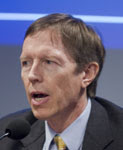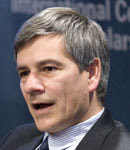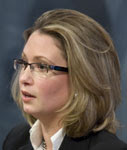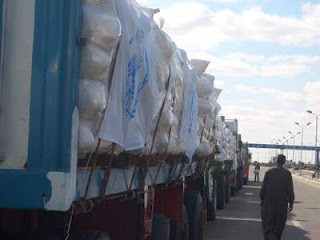-
This Just In: Panel Ponders Perils to Planetary Reporting
›February 6, 2009 // By Peter Dykstra I’m a little over halfway through my brief stay here at the Wilson Center. This fellowship was made possible by CNN: They laid me off, along with my entire science, tech, and environment news team, in December.
I’m a little over halfway through my brief stay here at the Wilson Center. This fellowship was made possible by CNN: They laid me off, along with my entire science, tech, and environment news team, in December.
We’re not alone: Many reporters and producers like us have found new meaning to the phrase “working journalist.” Non-working journalists now represent a significant piece of the pie.
Rightly or wrongly, many top news executives view beats like science and environment as peripheral to the journalistic mission, or at least to the business plan, of their organizations. Attention to these topics in the general media has a hard time competing with things viewed as more central, whether it’s politics or Paris Hilton.
On Thursday, February 12, in the Wilson Center’s Flom Auditorium, we’ll celebrate Lincoln’s 200th birthday by discussing how to make sure science and environment reporting doesn’t perish from this earth.
Two of the most accomplished science and environment reporters in Washington will join us: Seth Borenstein of the Associated Press and Elizabeth Shogren (not yet confirmed) of NPR. Seth and Elizabeth were among the best chroniclers of the environmental controversies that marked the Bush era, and are closely tracking the promised “change” that may (or may not) be underway in the Obama administration. Both are alumni of news organizations that have recently seen traumatic change: Seth as a correspondent for the Washington Bureau of Knight-Ridder, and Elizabeth for the Los Angeles Times.
Also on the agenda is the future of journalism itself: Newspapers as we now know them may be terminally ill; TV broadcast news as we know it may be five or 10 years behind. Panelist Jan Schaffer, director of J-Lab at American University, will bring her expertise on new- and community-based media. J-Lab is a journalism R&D; center, focusing on providing both guidance and financial support to citizen journalism projects. Jan, a former Philadelphia Inquirer editor and Pulitzer Prize winner, will help us see the way to what journalism will look like 10 and 20 years from now.
Space is limited, so RSVP to the Wilson Center’s Environmental Change and Security Program soon. If you can’t make it to D.C., you can watch the webcast live.
Photo: Peter Dykstra. Courtesy of Dave Hawxhurst and the Woodrow Wilson Center.
Peter Dykstra is the former executive producer for science, technology, environment, and weather at CNN, and a current public policy scholar at the Woodrow Wilson Center. He also writes for www.mnn.com. -
Watch: Peter Gleick on Peak Water
›February 5, 2009 // By Wilson Center Staff“The concept of ‘peak water’ is very analogous to peak oil…we’re using fossil groundwater. That is, we’re pumping groundwater faster than nature naturally recharges it,” says Peter Gleick in this short expert analysis from the Environmental Change and Security Program. Gleick, president and co-founder of the Pacific Institute and author of the newest edition of The World’s Water, explains the new concept of peak water.
-
VIDEO: Kent Butts on Climate Change, Security, and the U.S. Military
›February 5, 2009 // By Wilson Center Staff“Climate change is an important issue that can be addressed by all three elements of the national security equation: defense, diplomacy, and development,” says Kent Butts, in this short expert analysis from the Environmental Change and Security Program. Kent Butts, professor of political-military strategy at the Center for Strategic Leadership, U.S. Army War College, makes the case for considering global climate change a nontraditional threat to security and discusses how the U.S. military is reacting to a changing climate.
-
Developed World’s Dominance Declines with Age, Say Demographers
›February 5, 2009 // By Will Rogers “The whole world is aging, and the developed countries are leading the way,” said Neil Howe of the Center for Strategic and International Studies (CSIS) at a January 27, 2009, Wilson Center discussion of his latest report, The Graying of the Great Powers: Demography and Geopolitics in the 21st Century. Demography is as close as social science comes to predicting the future, Howe explained, presenting the geopolitical consequences of demographic trends over the next 50 years. Howe and co-author Richard Jackson, also of CSIS, were joined by Jennifer Sciubba of Rhodes College, who urged them and other demographers to explore how population trends interact with additional variables, such as environmental degradation, economic recession, and conflict.
“The whole world is aging, and the developed countries are leading the way,” said Neil Howe of the Center for Strategic and International Studies (CSIS) at a January 27, 2009, Wilson Center discussion of his latest report, The Graying of the Great Powers: Demography and Geopolitics in the 21st Century. Demography is as close as social science comes to predicting the future, Howe explained, presenting the geopolitical consequences of demographic trends over the next 50 years. Howe and co-author Richard Jackson, also of CSIS, were joined by Jennifer Sciubba of Rhodes College, who urged them and other demographers to explore how population trends interact with additional variables, such as environmental degradation, economic recession, and conflict.
Danger: Demographic Decline Approaching
“Populations in most developed countries will not only age, but stagnate or decline,” due to falling fertility and rising longevity, said Howe. Without “sizable immigration,” he warned, the populations of countries like the United States, France, Great Britain, Canada, Germany, and Japan will decline. As developed countries’ populations shrink, they will lose military might, savings and investment, entrepreneurship, and cultural influence. “Voltaire once said that God is on the side of biggest battalions,” Howe reminded the audience.
Developing Toward Greater Peace Jackson explained that the developing world is in the midst of the “demographic transition”—the drops in mortality and fertility that generally accompany economic and social development. Since 1970, the developing world’s overall fertility rate has declined from 5.1 to 2.9 children per woman, and its overall population growth rate has dropped from 2.2 percent to 1.3 percent per year, according to Jackson. Additionally, the median age has risen from 20 to 26 years old, “a cause for hope and optimism about the future,” Jackson argued, as countries with more balanced population age structures tend to be more democratic, prosperous, and peaceful than countries with extremely young ones.
Jackson explained that the developing world is in the midst of the “demographic transition”—the drops in mortality and fertility that generally accompany economic and social development. Since 1970, the developing world’s overall fertility rate has declined from 5.1 to 2.9 children per woman, and its overall population growth rate has dropped from 2.2 percent to 1.3 percent per year, according to Jackson. Additionally, the median age has risen from 20 to 26 years old, “a cause for hope and optimism about the future,” Jackson argued, as countries with more balanced population age structures tend to be more democratic, prosperous, and peaceful than countries with extremely young ones.
But despite the long-term possibility of a world transitioning toward greater peace and prosperity, the developing world will still experience near-term shocks. The timing and pace of the demographic transition varies widely by country and region, with some countries transitioning too fast or too far, said Jackson. These trends could push developing countries toward social collapse by acting “as a kind of multiplier on all the stresses of development,” explained Jackson—for instance, causing China “to lurch even more toward neo-authoritarianism.”
Crisis of the 2020s
Global demographic trends will converge in the 2020s to make that decade “very challenging,” said Howe. The developed world will undergo hyper-aging, population decline, and flattening GDP growth, along with rising pension and health care costs, Jackson noted. The Muslim world will experience a decade of temporary youth bulges, as the large generation that was born between 1990 and 2000 has children. The populations of Russia and Eastern Europe will implode, and Russia’s geopolitical strength and influence will wane. Meanwhile, China will experience a decade of “premature aging”; due to its one-child policy, it will become “gray” before it achieves the per capita GDP of most aging countries.
Demography and Public Policy Sciubba praised the report’s comprehensive, policy-friendly approach to demography, but urged the authors to remain true to the nuances of their topic, even in their conclusions and recommendations. “Policymakers like to know what we don’t know and what we do know. And with population aging and national security, often there’s a lot more of what we don’t know than what we do know,” she said. “Going into the future, we need more of an emphasis on places where policymakers can make a difference,” said Sciubba. “Opportunities matter just as much as challenges.”
Sciubba praised the report’s comprehensive, policy-friendly approach to demography, but urged the authors to remain true to the nuances of their topic, even in their conclusions and recommendations. “Policymakers like to know what we don’t know and what we do know. And with population aging and national security, often there’s a lot more of what we don’t know than what we do know,” she said. “Going into the future, we need more of an emphasis on places where policymakers can make a difference,” said Sciubba. “Opportunities matter just as much as challenges.”Photos: Neil Howe, Richard Jackson, and Jennifer Dabbs Sciubba. Courtesy of Dave Hawxhurst and the Wilson Center.
-
VIDEO: Jim Jarvie on How Humanitarian Groups Are Responding to Climate Change
›February 5, 2009 // By Wilson Center Staff“We recognize that in dealing with climate change, what we do is modest….But unless we get the message out and find partners who can really take it to large scale, our efforts aren’t futile, but they’re of little value over the next 30 to 50 years, which is indeed the time frame we ought to be thinking on,” says Jim Jarvie in this short expert analysis from the Environmental Change and Security Program. Jarvie, director of climate change, environment, and natural resources at Mercy Corps, discusses why humanitarian development organizations must respond to new climate challenges. -
In the Wake of Conflict, Gaza Faces Severe Public Health Challenges
›February 4, 2009 // By Lauren Herzer Risi
An 18-month blockade, three weeks of intense bombardment, and continuing sporadic violence are setting up the Gaza Strip for a “devastating humanitarian crisis,” according to the UN Office for the Coordination of Humanitarian Affairs. As of January 31, 1,380 Palestinians had been killed and 5,380 had been injured in the conflict, including many civilians. Additionally, the World Health Organization recently warned that…
Enduring [health] risks include complications and excess mortality in patients with chronic diseases as a result of the suspension of treatment and delayed access to health care during the conflict; diarrhea outbreaks from water-borne and food-borne diseases as a result of the lack of access to clean water and sanitation and the weak public health surveillance system; as well as long-term mental health problems as a result of the conflict.
Slightly more than twice the size of Washington, D.C., with a population of 1.5 million people, the Gaza Strip is among the most densely populated regions in the world. Gaza’s high population density has likely compounded residents’ vulnerability to white phosphorus, a highly flammable chemical that provides smoke screens for troop movements. The outrage provoked by its use by the Israeli Defense Forces (IDF) stems from the intense, uncontrollable fires it causes. The IDF has admitted to using white phosphorus in Gaza against Hamas and is investigating whether it also used it against residents, which is prohibited by the 1980 Convention on Conventional Military Weapons.
In 2008, prior to the war, the UN Relief and Works Agency reported that despite the humanitarian assistance flowing to Gaza, 51.8 percent of households were below the poverty line, and unemployment was at an unprecedented high of 45.3 percent. Prior to the recent conflict, 80 percent of the population was dependent on aid from the United Nations.
Although the current ceasefire has allowed for a slight increase in access to Gaza, humanitarian agencies and aid workers still struggle to get supplies into the territory. Day after day, truckloads of supplies—everything from food, clothing, and baby formula to blankets, plastic tarps, and technical equipment to draw water from the ground—sit at border crossings in Egypt, waiting for permission to enter Gaza. While Egyptians blame the Israelis for limiting access, Israeli officials claim that the Egyptians have not done enough to coordinate the flood of aid. Regardless of who is to blame, it is clear that limiting the access of humanitarian workers and supplies is having dire consequences for the residents of Gaza.
Photo: Humanitarian cargo waits at the Rafah border crossing on the Gaza-Egyptian border on January 9, 2009. Photo courtesy of Ekram Elhuni (World Food Programme) and Flickr user Peter Casier. -
Weekly Reading
›The Feeding of the Nine Billion: Global Food Security for the 21st Century, a report from Chatham House, puts forth 10 proposals designed to make the global food system more resilient, sustainable, and equitable.
Strategic Implications of Global Health, a recent report from the National Intelligence Council, builds on a 2000 National Intelligence Estimate analyzing the links between global health and U.S. national security, but places more emphasis on non-infectious issues like maternal mortality, malnutrition, and chronic diseases.
Bill Gates’ first annual letter about his work at the Gates Foundation includes a chart showing that better overall health is linked to smaller families.
“How Much Would You Pay to Save the Planet? The American Press and the Economics of Climate Change,” a discussion paper from Harvard University’s Joan Shorenstein Center on the Press, Politics, and Public Policy, examines coverage of the economic debate over the Lieberman-Warner Climate Security Act of 2008.
Population Connection’s February 2009 Reporter features stories on Ghana’s slow progress on reproductive health and Thomas Friedman’s book Hot, Flat, and Crowded, among others.
The Economist examines the connections between failed states and conflict, terrorism, poverty, and disease. Failed states were a major concern of the recent U.S. National Defense Strategy. -
VIDEO: Christian Leuprecht on Demography, Conflict, and National Security
›January 29, 2009 // By Wilson Center Staff“Demographics are going to be to the 21st century what class cleavages were to the 19th century,” says Christian Leuprecht in this short expert analysis from the Environmental Change and Security Program. In this video, Leuprecht, an assistant professor at the Royal Military College of Canada, makes the case for the importance of demographic dynamics and their connections to conflict and security.
 A Publication of the Stimson Center.
A Publication of the Stimson Center.

 I’m a little over halfway through my brief stay here at the Wilson Center. This fellowship was made possible by CNN: They laid me off, along with my entire science, tech, and environment news team, in December.
I’m a little over halfway through my brief stay here at the Wilson Center. This fellowship was made possible by CNN: They laid me off, along with my entire science, tech, and environment news team, in December. “The whole world is aging, and the developed countries are leading the way,” said Neil Howe of the Center for Strategic and International Studies (CSIS) at a January 27, 2009,
“The whole world is aging, and the developed countries are leading the way,” said Neil Howe of the Center for Strategic and International Studies (CSIS) at a January 27, 2009,  Jackson explained that the developing world is in the midst of the “demographic transition”—the drops in mortality and fertility that generally accompany economic and social development. Since 1970, the developing world’s overall fertility rate has declined from 5.1 to 2.9 children per woman, and its overall population growth rate has dropped from 2.2 percent to 1.3 percent per year, according to Jackson. Additionally, the median age has risen from 20 to 26 years old, “a cause for hope and optimism about the future,” Jackson argued, as countries with more balanced population age structures tend to be
Jackson explained that the developing world is in the midst of the “demographic transition”—the drops in mortality and fertility that generally accompany economic and social development. Since 1970, the developing world’s overall fertility rate has declined from 5.1 to 2.9 children per woman, and its overall population growth rate has dropped from 2.2 percent to 1.3 percent per year, according to Jackson. Additionally, the median age has risen from 20 to 26 years old, “a cause for hope and optimism about the future,” Jackson argued, as countries with more balanced population age structures tend to be  Sciubba praised the report’s comprehensive, policy-friendly approach to demography, but urged the authors to remain true to the nuances of their topic, even in their conclusions and recommendations. “Policymakers like to know what we don’t know and what we do know. And with population aging and national security, often there’s a lot more of what we don’t know than what we do know,” she said. “Going into the future, we need more of an emphasis on places where policymakers can make a difference,” said Sciubba. “Opportunities matter just as much as challenges.”
Sciubba praised the report’s comprehensive, policy-friendly approach to demography, but urged the authors to remain true to the nuances of their topic, even in their conclusions and recommendations. “Policymakers like to know what we don’t know and what we do know. And with population aging and national security, often there’s a lot more of what we don’t know than what we do know,” she said. “Going into the future, we need more of an emphasis on places where policymakers can make a difference,” said Sciubba. “Opportunities matter just as much as challenges.”


